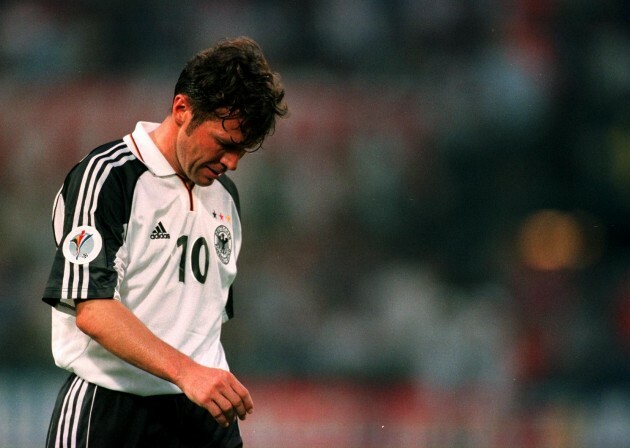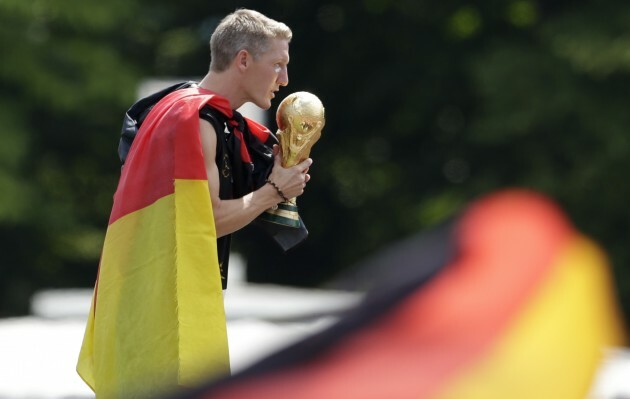
- Australia's largest state hits record-high COVID-19 cases despite weeks of strict lockdown. 'It's a tinderbox ready to explode,' one official said.
- eToro says crypto made up 73% of trading commissions in the last quarter, as retail customers dived in
- A flight attendant says she was too exhausted to report a passenger who shoved her when a flight was overbooked: report
- US jobless claims climb for first time in 5 weeks, to 353,000
IN JUNE 2000, Germany finished bottom of Group A in European Championships.
They won one point and scored one goal [both courtesy of Romania] in three games, losing to England and then 3-0 to Portugal on their way out.
“At the turn of the millennium German football stared disaster in the face – it completely lacked a professional foundation,” the writers of a 2011 report from the Bundesliga later said of the state of German soccer after the tournament.
“At the turn of the millennium German football stared disaster in the face – it completely lacked a professional foundation,” the writers of a 2011 report from the Bundesliga later said of the state of German soccer after the tournament.
You could say that Germany’s road to lifting the 2014 World Cup trophy at the Maracana started then, 14 years ago, when the Germans “stared disaster in the face” and promptly built the world’s most successful soccer factory.
A 2011 report commissioned by the Bundesliga, “10 Years Of Academies: Talent pools of top-level German football” is a thorough assessment of the youth system that turned the German national team into a juggernaut.
Borrowed
After the 2000 Euros Germany poured all its resources into producing great players starting at the grassroots level.
It borrowed methods from countries like The Netherlands — nations with small populations that have developed unique systems of identifying potential players in order to compete with larger countries — and instituted expensive and far-reaching reforms.
In February 2001 the Bundesliga made it mandatory for all 18 top-flight professional teams to run a youth academy — essentially a school for promising soccer players, with teams and coaches going all the way down to the under-12-year-old level. Later, academies became mandatory for all 36 professional teams in the top two German divisions.
Here’s a little more explanation from the Bundesliga’s 10-year report on its academy system:
“For clubs to be issued their license (the precondition for admission to any official competition), they had to hire full-time youth coaches, whose respective qualifications are taken into consideration when grading the academies, with those earning higher grades receiving higher funding. Moreover, appropriate training grounds had to be build, a medical department establish and co-operation with schools initiated.”
The better your academy is, the more funding you get. Under Bundesliga rules, a club with a top-rated three-star academy gets an additional €294,000 in funding every year — which is significant for smaller teams.
Between 2001 and 2011 professional teams in Germany spent ~€500 million on the development of youth soccer, according to the Bundesliga report. At the same time, the Deutscher Fußball-Bund — the German FA — started its own youth initiative at a cost of €9.5 million per year. According to the New York Times, there are now 366 German FA-operated youth centres in the country, serving 25,000 kids.
The investment paid off.
By the 2011-12 season, more than half of all Bundesliga players were part of the German academy system at one time. A full 20% of Bundesliga players came through the youth academies of the clubs they played for. The average age of the league went from 27 years old to 25 years old. In total, there were 5,400 players aged 11 to 22 in professional academies.
The sheer volume of youth teams after the 2001 academy mandate created a demand for professional coaches — all categorised and graded under new qualification guidelines.
In 2013, Borussia Dortmund and Bayern Munich competed in the final of the Champions League. Just over 13 months later, Germany are World Champions.
At a great cost, they have built a system that efficiently identified young players, gave them professional coaching, developed their skills in a professionalised environment, and turned them into great players.
That system is now spitting out one star player after another. Many of the stars of Germany’s World Cup-winning team are products of the post-2000 system. Mario Gotze (Borussia Dortmund), Mats Hummels (Dortmund), Manuel Neuer (Schalke), Per Mertesacker (Hannover), Toni Kroos (Hansa Rostock), Thomas Muller (Bayern Munich), and Mesut Ozil (Schalke) all came through Bundesliga academies. 14 of the 23 players who won the World Cup are 25-year-old or younger.
All of those guys could still be around for the 2018 World Cup, assuming they aren’t replaced by the next generation of academy-grown players.
This isn’t an accident. It’s not a once-in-a-lifetime “golden generation” of players. It’s the result of a sustainable system that should continue to produce great players for the foreseeable future.
Germany has a lot of things going for it as a football nation. The sport is insanely popular there, perhaps more than anywhere else in Europe. It’s the 2nd-largest country in Europe in terms of population, giving the national team a large pool to choose from. It has a large, thriving economy relative to its neighbourhoods.
When you take all those inherit advantages and apply a well-funded, incredibly thorough youth system, you get the sort of juggernaut national team we saw emerge in Brazil.
The 2014 World Cup was the end of a process that took more than a decade and a ton of money. In terms of Germany’s dominance on the world stage, though, it’s just the beginning.



